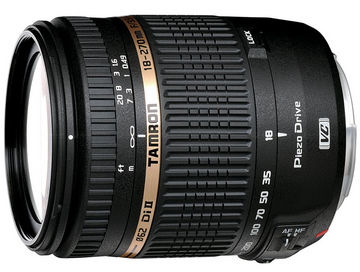Share your photographs...
We would love to feature your photographs on our equipment pages to help inspire others. We respect your copyright. Sharing is easy, just send us a link to your image on social media or your own website and remember to tell us about the following:
State that you own the copyright
Give us permission to use it
Include a link to your your web space
Include a caption for the image
Tell us about the equipment used

Upload date: 2019-01-22 Caption: Tamron 18-270mm f3.5-6.3 Di II VC PZD Sample image, © Tamron
Review this item...
Tell us how you would rate it overall:
There are no reviews for this item
Key Features
15X Zoom - largest focal length range in the world
Compact and light-weight, easy to always carry with you
Silent and very fast Piezo-ultrasonic motor
VC (Vibration Compensation) image stabiliser
Maximum magnification ratio 1:3.8 at a minimum focus distance of 0.49m
Di II lens - optimised for use with APS-C format digital sensors
For use with Canon DSLRs
PZD (PIEZO Drive)
Ultrasonic motors are divided into two categories depending on how the energy that moves the drive is generated: travelling wave motors and standing wave motors. The 18-270mm F/3.5-6.3 Di II PZD employs a newer technology, the PZD (PIEZO Drive), which functions according to the standing wave principle.
A standing wave ultrasonic motor utilizes high-frequency voltage to extend and turn the piezoelectric (piezoceramic) element, thus moving the entire element in a standing wave movement. The metal tip is the contact point of the element to the rotor, and moves in an elliptic motion from the swivelling motion of the moving element. The friction from this motion subsequently turns the rotor. Standing wave ultrasonic motors have the distinct advantage of being faster, quieter and more precise and compact than their travelling wave counterparts.
VC (Vibration Compensation)
Tamron’s VC mechanism employs a three-coil system, whereby three driving coils activate the shake-compensating VC lens group electromagnetically via three steel balls. The VC lens element is simply held in place by contact with the steel balls, resulting in smooth movement with little friction. This delivers a stable viewfinder image with excellent tracking performance and eliminates the blur from handheld shots for cleaner, crisper shots.
New VC mechanism (moving coil method)
Tamron’s original VC image stabilization mechanism utilizes a moving magnet system with heavy magnets. In the new VC unit the positions of the magnets and the coils are reversed, consequently the VC optical lens element is attached to the coil. The new VC mechanism employs a moving coil mechanism with lightweight coils, which reduces the load on the drive system. The lighter, more compact newly improved VC unit contributes to the lens’s overall lightweight and compact size.
Di-II
Lenses are designed for exclusive use on digital cameras with smaller-size imagers (also known as APS-C sensors). These lenses are not designed for conventional cameras and digital cameras with image sensors larger than 24mm x 16mm (IE. full-frame DSLRs, such as the 5D, 6D series).
| Attribute | Value |
|---|---|
| Lens Type: | Superzoom |
| Focal length - wide (mm): | 18 |
| Focal length - tele (mm): | 270 |
| Max aperture - wide: | 3.5 |
| Max aperture - tele: | 6.3 |
| Minimum aperture: | 22 |
| Minimum focus distance (m): | 0.5 |
| Image stabilisation: | Yes |
| Sensor format: | APS-C size |
| Lens mount: | Canon EF |
| Lens elements: | 16 |
| Lens groups: | 13 |
| Aperture blades: | 7 |
| Filter thread (mm): | 62 |
| Enlargement Ratio: | 1:3.8 |
| Autofocus motor: | PZD |
| MF switch: | Yes |
| Colour: | Black |
| Size: | 74.4 x 88 mm |
| Weight (g): | 450 |










